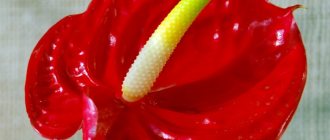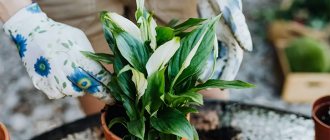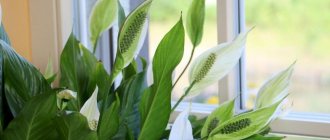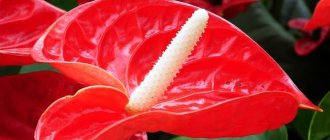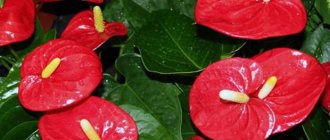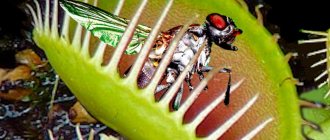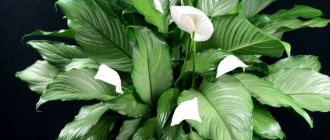Spathiphyllum is a decorative flowering rhizomatous perennial, an evergreen herbaceous plant of the Aronicaceae (Araceae) family. Natural habitat - coastal areas, lakes, equatorial forests, river valleys and reservoirs of South and Central America. It can be found in Haiti, the Philippines, Brazil, Colombia, Honduras and Peru. Today we’ll talk in more detail about how and under what conditions homemade exotic flowers bloom, as well as about the color palette of hybrid varieties and the difficulties of ripening inflorescences and buds.
What is the name of the flower “female happiness”, what does it look like?
Spathiphuillum wallisii came to Europe in 1824 from the Colombian jungle. The plant was first described by Gustavus Wallis. The researcher transferred several plant samples to Brussels, where the plants underwent adaptation and from where they began their march through the greenhouses of Europe
100 years later, Spathiphuillum wallisii has become a universally recognized favorite of amateur gardeners. In Russia the plant is known as
- Spathiphyllum/Spathiphyllum
- Sail
- Flagolist
- Woman's happiness
Description
- Evergreen stemless perennial, up to 60 cm high
- The leaves are glossy, dark green; grow directly from the soil, forming a dense bunch; leaf shape varies - from oval to elongated lanceolate
- What many people think is a white flower is actually a lance-shaped perianth (bract) wrapped around the inflorescence. The inflorescence of spathiphyllum is a spadix, the color of which varies from yellow to cream. Over time, the bracts and spadix turn green
- The plant blooms after 6 months of growth. Each flower lasts 5-6 weeks
What colors are bedspreads: description and photos of varieties
According to encyclopedic data, there are up to 50 specimens of generic varieties; they, in turn, are divided into 5 subgroups.
The discovery of exotics took place in the 19th century thanks to the German scientist Wallis. The most popular series of the bred selection is named in his honor. The first hybrid varieties became known in Europe in the mid-20th century.
In nature and in standard hybrids, the canvas has only 2 colors - snow-white and greenish.
Next, you can get acquainted with some varieties of spathiphyllum and study their photos.
Charming
It is distinguished by the rich whiteness of the flowers, the spikes are soft yellow or cream tones. The peculiarity is a refined aroma, especially in the early morning .
Domino
The rare Domino hybrid is distinguished by the extravagant coloring of the leaf plate, white spots on a green background, the strokes give it a special decorative effect, the snow-white blankets are in harmony with the picturesque pattern of the leaves.
Picasso
A variegated hybrid from the Netherlands, Picasso is a masterpiece of impressionism. The unique leaf pattern of mixed sectors of white and green shades is striking . A greenish scattering of decorative spots stands out on the surface of the pale white bedspread.
Cupido
The Cupido variety and its subspecies Compact are distinguished by the creamy-white color of large flowers with a pointed tip. The bush itself is compact and low.
Cannofolia
It has fragrant flowers, the petals are white with a greenish tint, and the ear is yellow-green.
Attention! Among natural and hybrid varieties, red and pink colors do not exist.
Spathiphyllum Red is found in catalogs. But this is nothing more than a marketing ploy. The bedspread is painted with chemical paints.
The dye is artificially introduced into the peduncle. The offspring from such “inventions” will still have white or greenish flowers.
Flower Women's happiness: how to care for it to bloom
Blooming spathiphyllum
To stimulate the appearance of new flowers, the peduncle with a wilted cob and spathe is cut off with a sharp knife or pruning shears. This should be done as close to the ground as possible
The flowering of spathiphyllum is also affected by light, temperature, air humidity and the size of the flower pot.
Illumination
In summer there is partial shade, in winter there is full light. Never keep the plant in direct sun. Considering the natural habitat of Spathiphuillum wallisii - the herbaceous layer of the tropical forest - it is not surprising that the plant prefers diffused sunlight and feels great near windows facing north
General care
Wipe the leaves with a damp sponge and do not use flower polish.
Temperature
In winter - no lower than 13⁰С, optimal temperature - about 16-18⁰С. In summer - within 18-21⁰С. The higher the temperature, the higher the humidity should be
Important: the plant is afraid of drafts! Even in summer!
Humidity
At temperatures above 21⁰C, the plant requires daily spraying.
The rest of the time:
• in winter - 2 times a week
• in spring and autumn (at a temperature of 15-20⁰С) - 3 times a week
Advice. If, due to some circumstances, you cannot provide the plant with daily spraying, place the pot with the plant in a container (tray) with wet expanded clay or pebbles. Make sure that the bottom of the pot does not touch the water to avoid waterlogging of the soil.
Pallet with pebbles for indoor plants (design options)
Flower pot size
Abundant flowering occurs only after the root system of the plant has entwined the entire pot. Experienced flower growers say: “The tighter the pot, the more colorful the flower” and this simple truth applies to all flowering indoor plants
Spathiphyllum transplant
Women's happiness is replanted in the spring, when the indoor plant is gaining strength and is ready for change. The signal to start the procedure is the root system. As soon as it becomes crowded in the pot, it is necessary to prepare the soil. The ideal composition includes turf, deciduous soil, a little humus, river sand and peat, which are taken in equal proportions.
Expanded clay, broken brick, and charcoal are placed at the bottom of the pot as a drainage layer. Experienced flower growers who do not neglect folk recipes advise using pieces of walnut shells and chicken eggs for these purposes. A delicate graceful flower (look at the photo of spathiphyllum) responds well to such mineral supplements.
The new container should be slightly larger than the previous one. Don't overdo it! Otherwise, the roots will begin to grow, the emphasis will be on the leaves, and you will have to forget about the flowers. In order for the plant to take root faster, you need to:
- monitor hydration using a special sprayer;
- ensure normal watering with warm water;
- cover the flower with cellophane film, remembering to ventilate it daily.
Simple rules will help green pets adapt faster and gain strength.
IMPORTANT: Plastic retains moisture. Therefore, clay pots are considered the ideal container for spathiphyllum.
How to water the flower of Women's Happiness?
• In summer - 2-3 times a week
• In winter - once a week
Important: Water for irrigation should be at room temperature
Do not use distilled, bottled or filtered water. Regular tap water is a perfectly suitable liquid for watering indoor plants.
With some caveats:
- Before watering, the water should stand for 24-48 hours. In this case, the liquid must be in an open container. This will allow chlorine to evaporate, which, unfortunately, is present in tap water.
- aroid plants, incl. spathiphyllums react poorly to hard water
The effect of hard water on indoor plants
How to soften water for watering indoor plants?
The proportions are given for 1 liter of ordinary tap water. Choose the option that suits you
- 0.1-0.2 g oxalic acid
- 3 g wood ash
- 2-3 drops of vinegar (9%)
- 0.3-0.4 g citric acid
- 0.1 ml sulfuric acid
- 2-3 drops of lemon juice
Add the selected substance to the water and leave to settle
Important: do not use boiled water (even at room temperature) for irrigation! Exposure to high temperatures deprives water of dissolved air. The use of such water can also cause putrefactive processes in the root system of the plant.
Earth for a flower Women's happiness
The ideal soil for the plant is a mixture consisting of 1 part fertile clay soil and 1 part coarse sand (not construction or marine)
Most companies specializing in the production of soils and substrates for indoor plants, as a rule, indicate on the packaging information about which plants the soil mixture is formulated for. Feel free to purchase a substrate formulated for aroid or flowering tropical plants.
Soil for spathiphyllum
Flower Women's happiness: how to replant
The plant should be replanted immediately after purchase. Then the spathiphyllum needs to be replanted every 3-5 years
The need to move the flower to a freer pot is indicated by the root system of the plant protruding to the surface
Flower growers recommend replanting plants in the spring, which is associated with the natural biological rhythms of flowers. But spathiphyllums have slightly different rules and requirements. The main condition is the air temperature within +20⁰С (not lower!), and the time of year does not matter.
So,
- Prepare a pot for replanting. Its diameter should be 2-3 cm larger than the diameter of the previous flowerpot. Be sure to pour boiling water over the inside of the flowerpot
Interesting: Feng Shui experts recommend using round-shaped flowerpots in metallic color for spathiphyllums.
- Carefully remove the plant from the previous pot. To simplify the extraction process, wet the soil in the flower pot well
Removing spathiphyllum from a flowerpot
- Be sure to free the plant roots from drainage (if used) and soil residues
Freeing roots from drainage and soil
- Unfortunately, the flower stalks need to be cut off. This will allow the plant not to waste time and energy on flowering and setting seeds.
Removing flower stalks
- Leaves that are too young and those that are beginning to wilt must be removed. Brown, scaly remains of the bases of old leaves also break off
Trimming leaves and removing the bases of old leaves
- Be sure to carefully examine the root system of the plant. Root threads that are too long and areas with signs of rot should be pruned. Sprinkle the root sections with powdered activated carbon or cinnamon.
- Check that the flowerpot you choose has through holes at the bottom (such holes serve as a kind of drainage system). Another prerequisite for the flowering life of a plant: the presence of a drainage layer at the bottom. Drainage may consist of small pebbles, brick fragments or expanded clay. The latter can be purchased at any store specializing in the sale of indoor plants. The thickness of the drainage layer is 1.5-2 cm. And only now can soil substrate be poured into the flowerpot (half the volume of the flowerpot)
- Place the plant in the center of the container. Try to evenly distribute the roots of the spathiphyllum, filling the entire surface of the soil. Cover the plant's root system with the remaining soil
Distribution of spathiphyllum roots during transplantation
- Note! In its natural habitat, spathiphyllum has a developed system of aerial roots. Aerial roots are also present in indoor plants. There is no need to dig them deep into the soil!
Left: what the aerial roots of spathiphyllum look like. Right: position of aerial roots when transplanting the plant correctly
- Lightly compact the soil substrate. Check that the flower rosette is securely fixed in the ground. Water the soil well. During the first heavy watering, it usually settles. To compensate for subsidence, add a little more soil to the flowerpot.
Flower Women's happiness: how to replant
- After transplantation, pamper Women's happiness with spraying
Care after transplant
Tip: if you can’t wait to see the spathiphyllum blooming again, give it a mini-greenhouse. Wrap the flower in transparent polyethylene to prevent rapid evaporation of moisture and create an ideal microclimate. Water and spray the flower as usual
Mini-greenhouse for spathiphyllum
Advice: it is better to replant flowers during the waxing moon
Why does spathiphyllum not bloom?
Women's happiness does not bloom all the time. If it's just a rest period, there's nothing to worry about.
Other natural reasons why a plant produces only leaves:
- the bush is too old;
- Spathiphyllum has undergone division;
- When grown from seeds, it will take 3 years for spathiphyllum to bloom.
Stimulants
The plant will not produce new buds for a long time if it has previously been exposed to stimulants. Domestic greenhouse farms usually use them sparingly, but flowering crops that came from Holland are literally crammed with chemicals. Professional activators have a prolonged effect, the bush “shoots” with abundant flower stalks and is greatly depleted.
To this should be added the keeping in not very comfortable conditions and improper care - it is simply not possible to surround women’s happiness with proper care on the road or in the store. Often, at the end of the flowering period, the imported plant dies. If he survives, he will recover for a long time.
Sometimes even the most attentive and competent owners have to wait 2 years for the Dutch spathiphyllum to begin to bloom again.
Transfer
Another problem is that when moved to a new pot, a bush that previously produced many buds may not bloom again. If this is normal stress after a transplant, and you just need to wait.
Other reasons:
- deepening of the root collar - this is destructive for spathiphyllum, the petioles rot, there is no talk of any flowering, only an urgent new transplant will help to save the plant;
- the bush was divided into parts, first it must recover from stress, heal injured areas, grow green mass - all this takes time;
- a large pot - until the roots entwine the earthen ball, the spathiphyllum not only refuses to bloom, but also does not grow;
- During the operation, many leaves were cut off, and only they can provide plastic substances and moisture to the flowers; first, the green mass should be restored, and then wait for the buds to emerge.
If the old bush has grown so much that there is almost no substrate left in the pot, it has stopped blooming, or grows poorly, you just need to divide it into parts, replant it and wait.
Care errors
Spathiphyllum does not bloom if it is not maintained correctly:
- Feeding should be regular - nutrients are primarily spent on leaf development. But if there is a lot of nitrogen in the fertilizers and not enough phosphorus or potassium, the spathiphyllum fattens and will not bloom. This usually happens when using mullein infusion or fertilizers for decorative leafy crops. They are good at the beginning of the growing season, then the drug needs to be changed.
- Light - women's happiness does not bloom in the shadows, as well as under scorching direct rays.
- Air humidity should be constantly high. Dryness is considered an extremely unfavorable factor; spathiphyllum spends all its energy on survival.
- Watering - female happiness will refuse to bloom if the leaves regularly drop due to dryness, or the roots do not have enough oxygen due to stagnant water.
- Incorrect substrate - continuation of the previous paragraph. Excessively dense sours, consisting only of non-moisture-intensive components, has excellent permeability, but the root constantly suffers due to lack of water.
- If the house is too cold, the spathiphyllum will not bloom; in the heat, the already opened bedspreads quickly age, and new ones do not emerge.
- Drafts are contraindicated for the plant. This is a strong stress factor.
- Pests and diseases weaken the bush and do not contribute to the formation of flower stalks. If they do form, you should not rejoice, but remove the arrows as quickly as possible in order to save the plant.
- You should not leave shoots with green covers. Trimming old flower stalks stimulates the formation of new buds, and if the owners like them, the stems can be placed in water.
- No rest period. Spathiphyllum does not belong to continuously flowering crops, although they also need rest for at least a month. If a woman’s happiness constantly threw out new buds throughout the year, the next period of rest may drag on for a long time.
When pollination has occurred and seeds have sprouted, spathiphyllum considers the main function of any plant organism - procreation - to be completed. All efforts will be devoted to ripening the seeds.
Women's happiness (flower): reproduction
The flower of female happiness multiplies by division. This means that flower transplantation is completely compatible with propagation
After removing the plant from the pot, you should carefully and slowly divide the main rosette of the plant into several sections. Make sure each one has a viable section of root system
Spathiphyllum propagation
Next, follow the tips described in the previous part of the article.
Flower of female happiness: leaves turn yellow and black
Appearance of a “sick” spathiphyllum
Yellow and black leaves indicate two completely different problems. And the solutions to these problems are different.
- Yellow leaves of the plant indicate too much bright sunlight in your pet's life. Provide the plant with partial shade and everything will work out
- Sometimes yellow leaves may indicate a red spider mite infestation. In this case, a cobweb may appear on the back side of the leaf plate. Be sure to treat the plant with a systemic insecticide, which can be purchased at flower shops
Important: If you have a lot of plants, you will have to process them all!
- Pay attention to which leaves turn yellow, old or young. For older leaves, yellowing is part of the natural dying process.
- The appearance of dry black tips on the leaves indicates insufficient moisture. Unfortunately, in a city apartment this is a common phenomenon even if the plant is frequently sprayed
- Blackening, which affects a large area of the leaf, may indicate hypothermia of the root system (especially in winter), excess moisture in the soil (overwatering), overfeeding with fertilizers
Why does the flower of Women's Happiness wither?
Wilted spathiphyllum
- Many gardeners make the same mistake: they overdry the earthen ball. By watering a flower in the generally accepted way (from above), you only moisten the top layer of soil. This may not be enough for the normal life of the plant, because the main root system is located below. And moisture may not reach the lower layers of the earthen coma. That is why the soil in flower pots is moistened in a very interesting way: simply place the container with the flower in a bucket or deep bowl of water. Thus, the soil is moistened from the bottom up, saturating the plant’s root system and drainage layer with moisture. A sign of sufficient moisture saturation is the formation of a moist halo around the flower rosette.
- Another reason for the wilting of spathiphyllum is saturation with moisture and, as a consequence, the occurrence of rotting of the roots. The main sign indicating rotting of the root system is constantly moist soil (even with infrequent watering). The plant needs to be replanted immediately! How to do this is described at the beginning of the article.
How does spathiphyllum begin to bloom?
The standard time frame for flowering of sratiphyllum is spring . Starting from the end of March, the plant wakes up and growth processes are activated. The beginning of flowering is April-May.
Some hybrid varieties (for example, Strauss, Chopin, Variegated) under special conditions and additional light stimulation bloom twice per season:
- spring natural flowering - May or late April;
- after a short period of rest at the end of November - beginning of December (subject to additional lighting and feeding with growth stimulants).
Fact . The hybrid variety Abundantly Flowering lives up to its name - under optimal conditions it generously produces flower stalks throughout the year. And when cut it lasts up to 2-3 months.
How to save a flower Women's happiness. Flower female happiness illness
In addition to the above recommendations, take into account that the plant may also suffer from a deficiency or excess of certain microelements, as well as be infested by pests
Causes and signs of plant diseases
First determine the cause of the disease and only then take measures to save the plant
Flower Women's happiness: signs and superstitions
Spathiphyllum has become a worthy successor to the once popular calla lily. Along with its popularity, spathiphyllum also inherited magical properties.
- The flower is considered to be a female amulet, capable of not only protecting its owner and her home from all sorts of troubles and misfortunes, but also helping to make the right decisions.
- Esotericists say that spathiphyllum should be in marital bedrooms and children's rooms, since the energy of the flower strengthens family ties
- There is an opinion that the plant helps a woman become more confident and attractive, awakening hidden energy reserves in her
Six unusual facts from the life of a plant
Spathiphyllum is one of the flowers covered in myths and legends. The plant is said to:
- Strengthens family ties. Married couples in whose home Women's Happiness has taken up residence quarrel less often, and divorce does not occur.
- Affects the conception of offspring. The barely perceptible aroma improves the health of expectant mothers. Their children are born strong.
- Attracts money, protects against poverty. That is why before planting a flower it is advised to place a coin at the bottom of the pot. Sometimes money is placed under the container. But it is recommended to do this during the dormant period, when the plant is resting from flowering.
- Like a litmus test, it will help you understand how much your loved one values their feelings. If a young man gives a girl spathiphyllum, and it takes root in her house, you can be sure of the devotion of the chosen one.
- Helps the indigenous people of South America perform mating rituals. If they are carried out during the flowering period of Women's happiness, the union will be strong.
- Fights stress. Therefore, the flower has become a common decoration for offices and hotels.
Knowing the rules for caring for a plant indoors, understanding how to water, replant, and care for spathiphyllum, you can achieve almost uninterrupted flowering. A pet will purify the air in the apartment and bring harmony and joy to the house.

